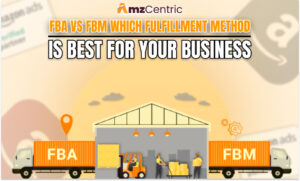
FBA vs. FBM: Which Fulfillment Method Is Best for Your Business?
Amazon has revolutionized e-commerce by providing sellers with two distinct fulfillment options: Fulfilled by Amazon (FBA) and Fulfilled by Merchant (FBM). Both methods offer unique advantages, but the choice between them can significantly impact your business’s success. This blog explores the pros and cons of each approach, helping you determine the best fit for your goals and resources.
Understanding FBA and FBM
What is FBA (Fulfilled by Amazon)?
With FBA, Amazon handles the storage, packaging, shipping, and customer service for your products. Sellers send inventory to Amazon’s fulfillment centers, and Amazon takes care of the rest.
Key Features of FBA:
- Amazon Prime eligibility
- Fast shipping and delivery
- Amazon handles returns and customer service
What is FBM (Fulfilled by Merchant)?
In FBM, the seller takes full responsibility for storage, packaging, shipping, and customer service. This method is ideal for businesses with robust logistics operations.
Key Features of FBM:
- Full control over inventory and shipping
- Lower reliance on Amazon’s infrastructure
- Customizable customer service
FBA vs. FBM: A Comparative Analysis
1. Cost Considerations
- FBA: Sellers pay fees for storage, fulfillment, and returns. While these fees can add up, they often justify the cost through time savings and enhanced customer trust.
- FBM: You save on Amazon’s fulfillment fees, but you must manage your own warehousing, shipping, and staffing, which could increase operational costs.
Tip: Use Amazon’s fee calculator to evaluate the financial impact of each model based on your product type and sales volume.
2. Scalability
- FBA: Ideal for businesses experiencing rapid growth or high order volumes. Amazon’s logistics network can handle fluctuations in demand without added strain on your operations.
- FBM: Works well for smaller-scale businesses or those with niche products, but scaling may require significant investment in infrastructure.
Best For: High-growth sellers should lean toward FBA, while FBM suits sellers with steady or manageable demand.
3. Customer Experience
- FBA: With Amazon’s Prime shipping, your customers receive fast, reliable delivery. Plus, Amazon handles customer inquiries, reducing your workload.
- FBM: Offers a more personalized approach to customer service but lacks the speed and trust associated with Amazon Prime.
Key Insight: If customer satisfaction and speed are critical, FBA has a clear advantage.
4. Inventory Control
- FBA: You must send inventory to Amazon’s warehouses, which may limit oversight and flexibility. Long-term storage fees apply if items remain unsold.
- FBM: Full control over your inventory means you can manage stock levels, returns, and restocking at your discretion.
Best For: Sellers with high-turnover products benefit from FBA, while FBM is ideal for low-turnover or seasonal items.
5. Branding Opportunities
- FBA: Amazon’s branding dominates the customer experience. Your packaging will feature Amazon branding rather than your own.
- FBM: Allows for branded packaging and a more customized unboxing experience, which can enhance brand loyalty.
Takeaway: If branding is a priority, FBM offers more flexibility to showcase your identity.
How to Decide: Key Questions to Ask Yourself
- What are your profit margins?
FBA fees can eat into thin margins, so ensure your pricing accounts for these costs.
- What’s your sales volume?
High-volume sellers often benefit from FBA’s streamlined logistics, while FBM suits smaller-scale operations.
- Do you have storage and logistics capabilities?
If you lack infrastructure, FBA can simplify your operations.
- How important is branding?
If your goal is to build a direct connection with customers, FBM might be a better choice.
- Is fast shipping essential to your customers?
FBA ensures Prime eligibility, which is a strong selling point for many shoppers.
The Hybrid Approach: Combining FBA and FBM
Many sellers find success using a hybrid approach, leveraging the strengths of both FBA and FBM. For example:
- Use FBA for high-demand, fast-moving products.
- Use FBM for larger or slower-moving items to reduce FBA storage fees.
This strategy allows you to optimize costs, maintain control over certain products, and still benefit from Amazon’s Prime network for others.
Conclusion: Choose What Aligns with Your Goals
The decision between FBA and FBM depends on your business model, goals, and resources. FBA offers convenience, scalability, and Prime access, while FBM provides control, branding opportunities, and cost flexibility. Evaluate your unique needs and consider experimenting with both methods to find the perfect balance for your business.
Pro Tip: Regularly review your fulfillment strategy as your business evolves. What works today may need adjustments tomorrow.
Are you ready to choose the right fulfillment strategy for your Amazon business? Let us help you get started!



